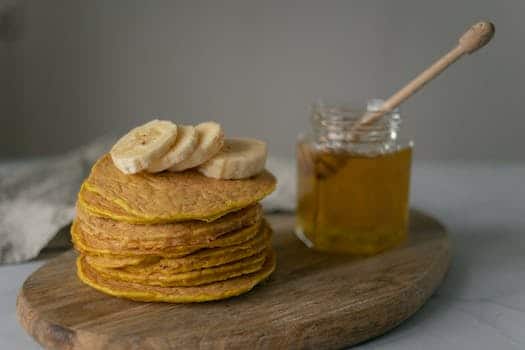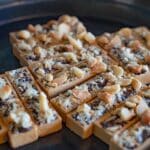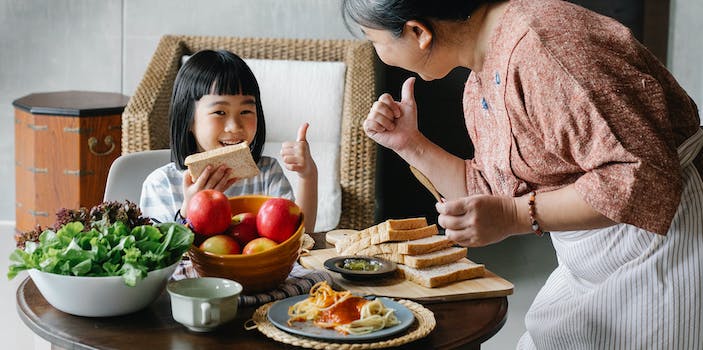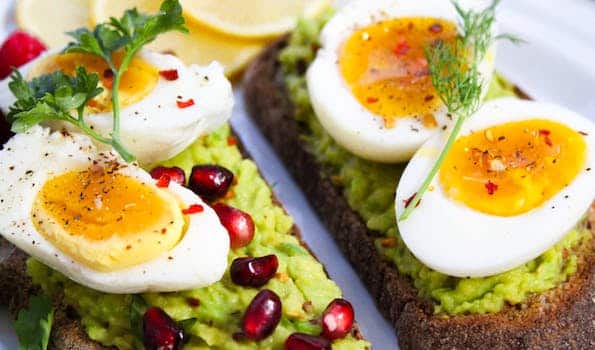Looking for a healthy and delicious breakfast option? Look no further than these gluten-free pancakes! Made with wholesome ingredients, they’re the perfect way to start your day on the right foot.
- 1. Gluten-Free Pancake Recipe
- 1.1. Introduction
- 1.2. Ingredients
- 1.3. Instructions
- 1.4. Tips for Perfect Pancakes
- 1.5. Serving Suggestions
- 2. Introduction
- 2.1. What are Gluten-Free Pancakes?
- 2.2. Why Make Gluten-Free Pancakes?
- 2.3. Health Benefits of Gluten-Free Pancakes
- 2.4. Challenges of Making Gluten-Free Pancakes
- 2.5. How to Overcome These Challenges
- 3. Ingredients
- 3.1. Gluten-Free Flour Blend
- 3.2. Baking Powder
- 3.3. Salt
- 3.4. Sugar
- 3.5. Eggs, Milk, and Butter
- 3.6. Optional Ingredients
- 4. Instructions
- 4.1. Step 1: Mix Dry Ingredients
- 4.2. Step 2: Mix Wet Ingredients
- 4.3. Step 3: Combine Wet and Dry Mixtures
- 4.4. Step 4: Heat Skillet or Griddle
- 4.5. Step 5: Cook Pancakes
- 5. Tips for Perfect Pancakes
- 5.1. Measure Ingredients Accurately
- 5.2. Don’t Overmix the Batter
- 5.3. Let the Batter Rest
- 5.4. Use the Right Temperature
- 5.5. Flip Pancakes Carefully
- 6. Serving Suggestions
1. Gluten-Free Pancake Recipe
Are you looking for a delicious and healthy gluten-free breakfast option? Look no further than this easy gluten-free pancake recipe! Made with almond flour and coconut flour, these pancakes are not only gluten-free but also high in protein and healthy fats.
Here’s what you’ll need to make these pancakes:
-1 cup almond flour
-1/4 cup coconut flour
-1 tsp baking powder
-1/4 tsp sea salt
-3 large eggs
-1/4 cup unsweetened almond milk
-1 tbsp maple syrup
-1 tsp vanilla extract
To begin, whisk together the almond flour, coconut flour, baking powder, and sea salt in a bowl. In another bowl, beat the eggs and then add in the almond milk, maple syrup, and vanilla extract. Mix well.
Next, add the dry ingredients to the wet ingredients and stir until well combined. Let the batter sit for a few minutes to thicken.
Heat a non-stick skillet over medium heat and add a small amount of oil or butter. Using a 1/4 cup measure, pour the batter onto the skillet and cook for 2-3 minutes on each side or until golden brown.
Serve your pancakes with your favorite toppings, such as fresh fruit, almond butter, or maple syrup. Enjoy!
1.1. Introduction
Gluten-free diets have become increasingly popular in recent years, as more and more people discover the benefits of cutting out gluten from their diets. Whether you suffer from celiac disease, gluten intolerance, or simply want to reduce your gluten intake, there are plenty of delicious gluten-free recipes out there to try. In this article, we’ll be sharing a delicious gluten-free pancake recipe that’s perfect for a healthy breakfast. Not only is this recipe gluten-free, but it’s also packed with healthy ingredients that will leave you feeling satisfied and energized all morning long.
1.2. Ingredients
To make a delicious gluten-free pancake recipe, you’ll need the following ingredients:
– 1 cup gluten-free flour blend
– 1 tablespoon sugar
– 1 teaspoon baking powder
– 1/2 teaspoon baking soda
– 1/4 teaspoon salt
– 1 cup almond milk (or other non-dairy milk)
– 1 egg
– 1 tablespoon coconut oil (or other oil)
Mix together the dry ingredients in a bowl. In a separate bowl, whisk together the wet ingredients. Pour the wet ingredients into the dry ingredients and stir until just combined. Heat a non-stick pan over medium heat and lightly coat with oil. Pour 1/4 cup of batter onto the pan and cook until the edges start to dry and the surface begins to bubble. Flip and cook for an additional 1-2 minutes. Serve with your favorite toppings and enjoy!
1.3. Instructions
Ingredients:
– 1 cup gluten-free all-purpose flour
– 1 tablespoon sugar
– 1 teaspoon baking powder
– 1/4 teaspoon baking soda
– 1/4 teaspoon salt
– 1 egg
– 1 cup almond milk
– 2 tablespoons coconut oil, melted
– 1 teaspoon vanilla extract
Instructions:
1. In a medium bowl, whisk together the flour, sugar, baking powder, baking soda, and salt.
2. In a separate bowl, whisk together the egg, almond milk, coconut oil, and vanilla extract.
3. Add the wet ingredients to the dry ingredients and mix until just combined.
4. Heat a non-stick pan or griddle over medium heat. Scoop 1/4 cup of batter for each pancake onto the pan.
5. Cook until the edges start to dry and the surface is covered in bubbles, then flip and cook for another minute or until golden brown.
6. Serve with your favorite toppings, such as fresh fruit or maple syrup. Enjoy your delicious gluten-free pancakes!
1.4. Tips for Perfect Pancakes
For those who are looking for a delicious and healthy breakfast option, gluten-free pancakes are a great choice. However, making perfect gluten-free pancakes can be a challenge. Here are some tips to ensure your pancakes turn out perfectly every time:
1. Use a blend of gluten-free flours for a better texture and flavor.
2. Add xanthan gum to help bind the ingredients together.
3. Let the batter rest for 10-15 minutes before cooking to allow the flours to absorb the liquid.
4. Cook the pancakes on a low to medium heat to ensure they cook evenly and don’t burn.
5. Flip the pancakes only once and resist the urge to press them down with a spatula.
With these tips in mind, try out this delicious gluten-free pancake recipe for a healthy and satisfying breakfast!
1.5. Serving Suggestions
Serve these delicious gluten-free pancakes hot off the griddle with your favorite toppings like fresh berries, sliced bananas, or a drizzle of honey. For a savory twist, top with avocado and a fried egg. These pancakes also make a great base for a breakfast sandwich. Simply stack two pancakes with a slice of ham or bacon and a fried egg in the middle. Enjoy!
2. Introduction
Gluten-free diets have become increasingly popular over the years, and for good reason. Not only do they help those with celiac disease or gluten sensitivity, but they also offer a range of health benefits for everyone. Whether you’re looking to maintain a healthy lifestyle or simply try something new, these delicious gluten-free pancakes will make the perfect addition to your breakfast routine. Packed with nutrients and bursting with flavor, this recipe is sure to be a crowd-pleaser. So, let’s get cooking!
2.1. What are Gluten-Free Pancakes?
Gluten-free pancakes are pancakes that are made without wheat flour, which is the main source of gluten. Instead, gluten-free flours such as almond flour, rice flour, or cornmeal are used as a substitute. These pancakes are a great alternative for people who have celiac disease, gluten sensitivity, or those who simply want to avoid gluten in their diet. Not only are they healthy, but they can also be just as delicious as traditional pancakes. In fact, many people prefer the taste of gluten-free pancakes because they have a lighter and fluffier texture.
2.2. Why Make Gluten-Free Pancakes?
Gluten-free pancakes are a great option for those who have celiac disease or gluten sensitivity. Celiac disease is an autoimmune disorder that affects the small intestine, causing damage to the lining of the gut when gluten is consumed. Gluten sensitivity is a less severe condition, but it can still cause discomfort and digestive issues. Making gluten-free pancakes ensures that those with celiac disease or gluten sensitivity can still enjoy a delicious breakfast without any negative health consequences.
2.3. Health Benefits of Gluten-Free Pancakes
Gluten-free pancakes have become increasingly popular in recent years, as more and more people are discovering the health benefits of going gluten-free. Gluten-free pancakes are made with alternative flours such as almond, coconut, or rice flour, which are all gluten-free and provide a variety of health benefits. These flours are rich in nutrients and fiber, making them a healthier option than traditional wheat flour. Additionally, gluten-free pancakes are a great option for those with celiac disease or gluten intolerance, as they can enjoy pancakes without experiencing any negative side effects. In this article, we will explore the health benefits of gluten-free pancakes and provide a delicious recipe that you can enjoy for a healthy breakfast.
2.4. Challenges of Making Gluten-Free Pancakes
When it comes to making gluten-free pancakes, there are a few challenges that you may face. One of the biggest challenges is finding the right combination of flours to use. Gluten-free flours can be quite different from traditional wheat flour, and it can take some experimentation to find the right mix that will give you the texture and flavor you’re looking for. Another challenge is getting the pancakes to rise properly without gluten. Finally, it can be difficult to get the pancakes to hold together and not fall apart when flipping them in the pan. Despite these challenges, with a little practice and the right recipe, you can make delicious gluten-free pancakes that are just as tasty as the traditional version.
2.5. How to Overcome These Challenges
Living a gluten-free lifestyle can be challenging, especially when it comes to finding delicious and healthy breakfast options. Fortunately, with this gluten-free pancake recipe, you can start your day off right without sacrificing taste or nutrition. However, there are still some common challenges that you may face when trying to make gluten-free pancakes. In this article, we will discuss how to overcome these challenges and create the perfect gluten-free pancake every time.
3. Ingredients
To make a delicious gluten-free pancake recipe for a healthy breakfast, you will need the following ingredients:
– 1 cup gluten-free all-purpose flour
– 1 tablespoon sugar
– 2 teaspoons baking powder
– 1/2 teaspoon salt
– 1 cup milk (dairy or non-dairy)
– 1 egg
– 2 tablespoons melted butter (or coconut oil for a dairy-free option)
Mix all of the dry ingredients together in a bowl, then add in the wet ingredients and stir until the batter is smooth. Heat a non-stick pan over medium heat and pour in 1/4 cup of batter for each pancake. Cook for 2-3 minutes on each side, or until lightly browned. Serve with your favorite toppings, such as fresh fruit, maple syrup, or whipped cream. Enjoy!
3.1. Gluten-Free Flour Blend
When it comes to making gluten-free pancakes, having the right flour blend is key. Instead of using traditional wheat flour, this recipe calls for a blend of gluten-free flours that work together to create the perfect texture and taste. Here’s what you’ll need to make your own gluten-free flour blend for this delicious pancake recipe:
3.2. Baking Powder
Baking powder is a crucial ingredient in any pancake recipe, gluten-free or not. It is a leavening agent that helps the pancakes rise and become fluffy. Baking powder is a combination of baking soda, cream of tartar, and sometimes cornstarch. In this gluten-free pancake recipe, we’ll be using a gluten-free baking powder to ensure that the pancakes are safe for those with gluten sensitivities.
3.3. Salt
Salt
Salt is an essential ingredient in almost every recipe, including this delicious gluten-free pancake recipe. It enhances the flavor of the ingredients and helps to bring out their natural taste. However, it is important to use salt in moderation, as excessive consumption can lead to health problems. In this recipe, we recommend using a pinch of salt to balance the flavors and make the pancakes taste even better.
3.4. Sugar
Sugar is a common ingredient in many pancake recipes, but it’s not always necessary. For this gluten-free pancake recipe, we’ll be using alternative sweeteners such as honey or maple syrup to add a touch of sweetness without sacrificing the health benefits. These natural sweeteners also have a lower glycemic index compared to refined sugar, making them a better option for those with blood sugar concerns. Plus, they add a delicious, unique flavor to the pancakes that you won’t find in traditional recipes. So, skip the sugar and try this healthier twist on a classic breakfast favorite!
3.5. Eggs, Milk, and Butter
Eggs, milk, and butter are key ingredients in many pancake recipes, and this gluten-free version is no exception. These ingredients provide the necessary moisture and richness to the pancakes, while still keeping them light and fluffy. For those who are lactose intolerant or vegan, there are many alternative options available, such as almond milk and vegan butter. Regardless of the variations, these ingredients are essential for a delicious and satisfying pancake breakfast.
3.6. Optional Ingredients
Optional ingredients for this delicious gluten-free pancake recipe include blueberries, sliced bananas, chopped nuts, or even a sprinkle of cinnamon. These ingredients add extra flavor and nutrition to the pancakes and can make for a more satisfying breakfast. However, the basic recipe is still delicious on its own, so feel free to customize it to your liking.
4. Instructions
To make a delicious gluten-free pancake recipe for a healthy breakfast, start by combining gluten-free flour, baking powder, salt, and sugar in a large bowl. In a separate bowl, whisk together eggs, milk, and melted butter. Pour the wet ingredients into the dry ingredients and mix until just combined. Heat a non-stick pan over medium heat and ladle the batter onto the pan. Cook until the edges start to dry and bubbles form on the surface, then flip and cook for an additional minute. Serve with your favorite toppings such as fresh fruit, maple syrup, or whipped cream. Enjoy!
4.1. Step 1: Mix Dry Ingredients
To start making your delicious gluten-free pancake recipe, the first step is to mix the dry ingredients. In a large bowl, whisk together the gluten-free flour, baking powder, salt, and sugar until well combined. Make sure to sift the flour to ensure there are no lumps. Mixing the dry ingredients first will help ensure that the batter is smooth and evenly mixed. Set the bowl aside once you’ve mixed everything together.
4.2. Step 2: Mix Wet Ingredients
In a separate bowl, whisk together the wet ingredients: almond milk, melted coconut oil, and vanilla extract. Make sure the coconut oil is not too hot when adding it to the mixture, as it can cook the eggs. Whisk until the ingredients are well combined.
4.3. Step 3: Combine Wet and Dry Mixtures
Once both the dry and wet mixtures are prepared, it’s time to combine them. Slowly pour the wet mixture into the dry mixture, stirring constantly with a whisk or fork. Continue to stir until the batter is smooth and there are no lumps. Be careful not to overmix the batter as this can result in tough pancakes. If the batter is too thick, add a little more milk. If it’s too thin, add a little more flour. The batter should be pourable, but not runny. Once the batter is ready, it’s time to cook the pancakes!
4.4. Step 4: Heat Skillet or Griddle
Heat a non-stick skillet or griddle over medium heat. Once the skillet or griddle is hot, test with a few drops of water. If the water sizzles and evaporates immediately, it’s ready. Using a 1/4 cup measuring cup, pour batter onto the skillet or griddle. Cook until bubbles form on top and the edges start to dry, then flip and cook for an additional 1-2 minutes until golden brown. Repeat with remaining batter.
4.5. Step 5: Cook Pancakes
Heat a non-stick skillet or griddle over medium-high heat. Scoop 1/4 cup of batter for each pancake onto the skillet. Cook until the edges of the pancake start to dry out and the surface is covered in bubbles, then flip and cook until the other side is golden brown. Repeat with remaining batter, adding more oil to the skillet as needed. Serve hot with your favorite toppings.
5. Tips for Perfect Pancakes
To make the perfect pancakes, start by preparing your ingredients ahead of time. This includes measuring out the flour, baking powder, and any other dry ingredients, as well as separating the egg whites from the yolks if necessary. When combining the wet and dry ingredients, be careful not to overmix the batter, as this can result in tough pancakes. Instead, mix until just combined and let the batter rest for a few minutes before cooking. To get a nice, even cook on your pancakes, use a nonstick pan or griddle and heat it up over medium-high heat. Use a ladle to pour the batter onto the pan, and cook until bubbles form on the surface, then flip and cook for another minute or two. Serve your pancakes hot with your favorite toppings, such as fresh fruit, maple syrup, or whipped cream.
5.1. Measure Ingredients Accurately
Accurately measuring ingredients is crucial for making perfect pancakes. Use measuring cups and spoons for dry ingredients like flour, baking powder, and sugar. For liquids like milk and oil, use a liquid measuring cup with clear markings. Make sure to level off the top of dry ingredients with a straight edge to ensure accuracy. Avoid packing flour into the measuring cup, as this can result in too much flour and dense, heavy pancakes.
5.2. Don’t Overmix the Batter
When making pancakes, it’s important not to overmix the batter. Overmixing can cause the gluten in the flour to develop, resulting in tough and chewy pancakes. To avoid this, mix the batter until all the ingredients are just combined. It’s okay if there are a few lumps in the batter. These will cook out when the pancakes are on the griddle.
5.3. Let the Batter Rest
Letting the batter rest is an important step in making perfect pancakes. Allowing the batter to rest for 10-15 minutes allows the gluten to relax and the ingredients to meld together, resulting in a fluffier and more cohesive pancake. It also gives the baking powder or baking soda time to activate, which will help the pancakes rise and become light and airy.
5.4. Use the Right Temperature
To make perfect pancakes, you need to use the right temperature. It’s important to heat your pan to the correct temperature before adding the batter. If the pan is too hot, the pancakes will burn on the outside and be undercooked on the inside. If the pan is not hot enough, the pancakes will be pale and greasy. A good way to test the temperature of the pan is to flick a few drops of water onto the surface. If the drops sizzle and evaporate immediately, the pan is ready.
5.5. Flip Pancakes Carefully
When it comes to flipping pancakes, it’s important to be gentle and patient. Use a spatula to loosen the edges of the pancake and make sure it’s not sticking to the pan before attempting to flip. Then, slide the spatula underneath and quickly and confidently flip the pancake. It may take some practice, but with a little patience and a steady hand, you’ll be flipping pancakes like a pro in no time!
6. Serving Suggestions
When it comes to serving suggestions for this delicious gluten-free pancake recipe, the options are endless. You can top your pancakes with fresh fruit, such as berries or sliced bananas, and a drizzle of pure maple syrup. For a savory twist, you can add some sliced avocado and a sprinkle of sea salt. Another great option is to spread some almond butter or peanut butter on top and sprinkle with chia seeds or flaxseeds for added nutrition. No matter how you serve them, these pancakes are sure to be a hit at your next breakfast gathering!
6.1. Classic Pancake Toppings
When it comes to serving gluten-free pancakes, the topping options are endless. However, sometimes it’s best to stick with classic pancake toppings that everyone loves. Here are a few ideas to get you started:
1. Fresh berries and whipped cream
2. Butter and maple syrup
3. Chocolate chips and sliced bananas
4. Peanut butter and honey
5. Cinnamon sugar and sliced apples
No matter which topping you choose, these gluten-free pancakes are sure to be a hit at breakfast time!
6.2. Healthy and Nutritious Toppings
When it comes to serving gluten-free pancakes, the toppings can make all the difference. Here are some healthy and nutritious topping ideas to try:
1. Fresh berries: Strawberries, blueberries, raspberries, blackberries – any type of berry will add a burst of flavor and antioxidants to your pancakes.
2. Nut butter: Whether it’s peanut butter, almond butter, or cashew butter, spreading a dollop of nut butter on top of your pancakes is a great way to add healthy fats and protein to your breakfast.
3. Greek yogurt: A dollop of plain Greek yogurt adds a tangy flavor and a boost of protein to your pancakes. For extra sweetness, drizzle with a touch of honey.
4. Chopped nuts: Walnuts, pecans, and almonds are all great choices for adding crunch and a dose of healthy fats to your pancakes.
5. Cinnamon and honey: For a simple yet flavorful topping, sprinkle your pancakes with cinnamon and drizzle with honey. This combination is both delicious and good for you.
6.3. Creative and Unusual Toppings
If you’re tired of the same old pancake toppings, try something new and creative with your gluten-free pancakes. Here are some unusual ideas to spice up your breakfast:
– Grilled peaches and honey
– Bacon and maple syrup
– Nutella and bananas
– Cinnamon apples and whipped cream
– Smoked salmon and cream cheese
These toppings are sure to impress your taste buds and make your breakfast more exciting. Don’t be afraid to experiment and try new combinations!
6.4. Pairing with Beverages
Pairing with Beverages:
These delicious gluten-free pancakes pair well with a variety of beverages. For a classic breakfast, serve them with a glass of cold milk or freshly squeezed orange juice. For a more decadent treat, try pairing them with a hot cup of coffee or a rich hot chocolate. For a healthier option, serve them with a cup of green tea or a fresh fruit smoothie. The possibilities are endless, so experiment to find your perfect pairing!
6.5. Making Pancake Breakfasts Special
To make pancake breakfasts extra special, try adding some fun serving suggestions. One idea is to set up a pancake bar with various toppings such as fresh fruit, whipped cream, chocolate chips, and syrup. Another option is to create pancake sandwiches with bacon, eggs, and cheese in between. You can also use cookie cutters to create fun pancake shapes for the kids. The possibilities are endless, so get creative and have fun with your pancake breakfasts!
Conclusion
In conclusion, this delicious gluten-free pancake recipe is a healthy and satisfying way to start your day. Enjoy the benefits of a nutritious breakfast without sacrificing taste!





